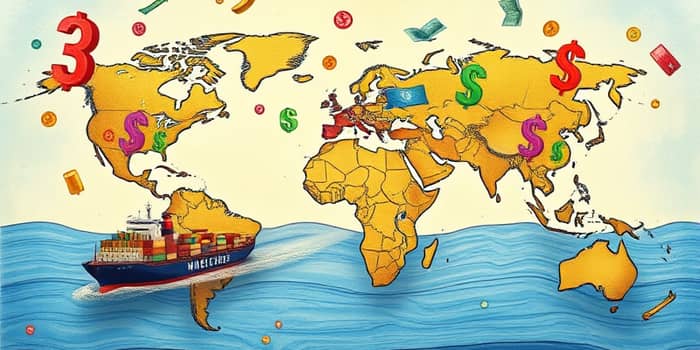
Exchange rates intimately influence cross-border transactions, affecting costs, profits, and strategic choices for companies, governments, and investors. In an era marked by heightened volatility, a clear grasp of currency dynamics is essential to thrive in global markets.
Currency fluctuations describe the changes in one currency’s value relative to another. These shifts are reflected in exchange rates, which evolve continuously due to trading in foreign exchange markets. The interplay of supply and demand, guided by central banks, institutional traders, and retail participants, sets these rates.
Key drivers include economic indicators such as GDP growth, inflation rates, and employment figures, which signal a country’s financial health. Geopolitical events—from elections and trade agreements to conflicts—can trigger rapid adjustments as market participants reprice risk.
global supply chain realignment and de-risking strategies have added a new dimension, as firms restructure sourcing to reduce exposure to volatile regions.
Understanding the mechanics of direct float, managed float, and pegged exchange rate regimes is fundamental for interpreting currency movements. Each regime offers different levels of stability and adjustment flexibility.
In 2024–2025, the US dollar has enjoyed periods of strength driven by higher Federal Reserve rates and safe-haven demand amid geopolitical tensions. This strength has placed pressure on emerging market currencies such as the Indian rupee and Brazilian real, which have seen 5–7% volatility affecting export margins.
According to Goldman Sachs, forecasts predict the dollar could weaken by roughly 10% against the euro and around 9% versus the yen and pound over the next twelve months, as US growth moderates and trade tensions persist.
Global trade value jumped by $300 billion in H1 2025. While nominal growth stood at 1.5% in Q1 with projections of 2% in Q2, much of the increase was due to higher prices for energy and commodities rather than a substantial rise in shipment volumes.
Central bank policies remain at the forefront. The European Central Bank and Bank of Japan are weighing rate adjustments to manage inflationary pressures, while emerging market authorities use foreign exchange reserves to stabilize local currencies.
Currency swings have immediate and tangible impacts on trade flows. A depreciating currency lowers export prices abroad, boosting demand, but also makes imports more expensive, affecting production costs and consumer prices.
Companies are increasingly integrating currency considerations into supply chain decisions, choosing suppliers based on currency stability as well as cost and quality metrics.
Shifts in exchange rates significantly alter the returns on overseas investments, often independent of an asset’s underlying performance. A strengthening dollar, for instance, reduces the value of repatriated earnings for US multinationals.
Financial institutions are expanding their currency risk teams and employing advanced analytics to predict likely exchange rate scenarios and hedge accordingly.
Emerging markets continue to experience the brunt of currency volatility. With limited monetary policy space and high external debt, countries like Brazil and South Africa face tougher choices between controlling inflation and supporting growth.
Developed economies such as the US and EU show more resilience but still confront uneven trade balances. The EU’s rising surplus, for instance, is partially linked to a stronger euro, which offsets lower volumes with higher values.
Network effects matter: intermediate goods crossing multiple borders can amplify currency risks along the supply chain, leading to unpredictable cost spikes at various production stages.
widening US deficits and growing EU surpluses reflect deepening imbalances that will continue to shape exchange rate trajectories and trade relationships.
Sectors such as automotive, electronics, and energy are particularly exposed due to their reliance on global inputs and just-in-time production models.
Businesses and governments are deploying an array of tactics to manage currency risk and promote stability.
Firms are also investing in currency risk management platforms, embedding real-time data feeds and scenario analysis into their treasury operations to anticipate and respond faster.
Persistent trade tensions, political fragmentation, and uneven vaccine rollouts in parts of the world pose ongoing risks to exchange rate stability. Any sharp escalation in tariffs or new sanctions could provoke rapid currency moves.
The concentration of global digital sales among the top five multinationals, which now account for 48% of revenues, introduces additional volatility. Large capital flows into or out of tech equities can have outsized effects on associated currencies.
Furthermore, unconventional monetary policies and high sovereign debt levels in several major economies raise the specter of sudden reappraisals by currency traders seeking yield or safety.
Looking forward, market participants must treat currency risk management as an ongoing imperative rather than a periodic project. Continuous monitoring, stress testing, and scenario planning for extreme moves will be crucial.
Policymakers should strive for transparent communication of monetary policy and foster international dialogue to mitigate disorderly currency adjustments. Targeted financial assistance and structural reforms can help emerging markets navigate external shocks.
For investors, a balanced approach combining diversified currency allocations, tactical hedging, and long-term views on fundamental drivers—such as interest rate differentials and growth differentials—offers the best protection against volatility.
Ultimately, mastering the complex interactions among trade balances, capital flows, and geopolitical events provides a strategic edge. By embracing robust risk management practices, leveraging global coordination, and investing in predictive analytics, stakeholders can convert currency fluctuations from threats into opportunities.
References













